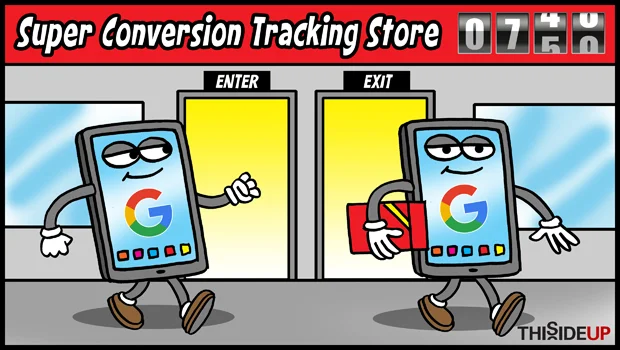Google’s Store Visits Metric in AdWords
Google’s Store Visits Metric in AdWords
If your business is purely online, marketing programmes like Adwords are a godsend. They give you all the statistics you could dream of on your campaign as well as on various Key Performance Indicators such as Return on Investment, conversion rates and sales goals, and they are 100% representative of your customers’ activity since all the buying cycle happens online, from research to purchase.
But if customers can buy your goods or services both online and instore, it gets a bit more difficult to get a clear picture on how your Adwords campaign is doing and where to invest. If the online conversion rate is lower than you would like, it could indeed indicate that your ad strategy needs to be reviewed. Or it could simply be that customers went to one of your stores to purchase something they saw online thanks to your Adwords campaign. In those cases, the impossibility to bridge the gap between online and offline behaviour can misinform businesses’ decisions and lead to over- or under-investment in online marketing.
Thankfully, Google recognised this issue and, in 2014, launched a metric that addressed it, ‘Store Visits’, to shed some light on how and where customers purchase consumer goods.
How does the technology work?
Google Maps isn’t just a handy tool to plan a route or find out where a point of interest is located. At its heart, it is a massive database of coordinates encompassing millions of buildings around the world. ‘Store Visits’ uses it, as well as a combination of information extracted from mobile phone towers, GPS signals and Wi-Fi signal strength, to refine people’s location in order to determine with a high level of accuracy which stores are visited.
The technology is also able to differentiate the nature of visits based on the time spent in the shop. For example, a one-minute visit could be nothing more than someone walking through a store to get somewhere else, while hours’ long visits are more likely to be staff members – both categories being discounted from visits’ numbers.
How accurate is it?
The important thing to understand about Store Visits is that it gives estimates, and estimates of visits, rather than sales. Tracking the movements of specific individuals is illegal - unless they are under surveillance for criminal activity - so Google uses only anonymous data from aggregators, which is then extrapolated from a representative sample.
The metric draws on results from ad clicks across all devices, not only smartphones and tablets, all Adwords campaign types, product listing ads and local inventory ads, and includes offline visits from the last 30 days of an ad click, but it is true that the person who clicked on your ad online is unlikely to be the very person who visits your store.
This feature protects people’s privacy and ensures that no action can be tracked back to someone specific, but it may make advertisers wonder how much they can trust those numbers. Google spoke out on the subject, to assure that the figures resulting from this technique were actually on the conservative side and that they expected the reality on the ground to beat the estimates.
It is also useful to know that 'Store Visits’ reports are at campaign level so if you want detailed results based on store location or region, you will need to break down Adwords campaigns accordingly.
Who is eligible for Store Visits?
Extrapolating accurately requires large samples, which means that qualifying advertisers are likely to be national or multinational chains able to generate enough data to give meaningful results. However, there is no doubt that it will eventually expand to smaller retailers and possibly to other types of businesses such as hotels, restaurants or cinemas.
In addition to, obviously, running an Adwords campaign, the criteria for eligibility are:
Businesses must have a location registered and verified with Google. That business must be associated with an Adwords campaign.
They must have multiple physical stores in eligible countries.
They must receive high volumes of ad clicks and in-store traffic.
They must have a Google My Business account linked to an AdWords account and if they have several stores, they must create each of them in Google My Business.
According to Google, case studies around the world have proved the usefulness of online to offline conversion data.
They cited PetSmart, for example, an American pet store chain whose Store Visits showed that 10 to 18% of clicks on online ads led to a store visit. A year after the launch of the programme, the internet giant reported that, thanks to the data provided by Store Visits, US retailers had noticed that their conversions rates from mobile search ads increased 10 times when they took into account store visits. Advertisers in the travel and car industry saw conversion rates double.
Two years into existence, Store Visits seems to be doing well and to have been embraced by a significant number of large multinationals, as Google announced in 2016 that it had measured over 1 billion of store visits globally, based on 1,000 advertisers in 11 qualifying countries.
Recent case studies included Nissan UK who found that 6% of mobile ad clicks resulted in a visit to one of their dealerships and Seven & I Holdings, a Japanese retailer, who found that 10% of searches on mobile devices led to a store visit.
Unfortunately this tracking feature is not yet available in New Zealand, as is the case with many other Google features such as call tracking. You can bet that when it does become available here, This Side Up will be first to put their hand up to try implement it for our clients. Given that Google Shopping hit NZ shores earlier in the year, we are expecting that store visits tracking capability won't be too far away!

